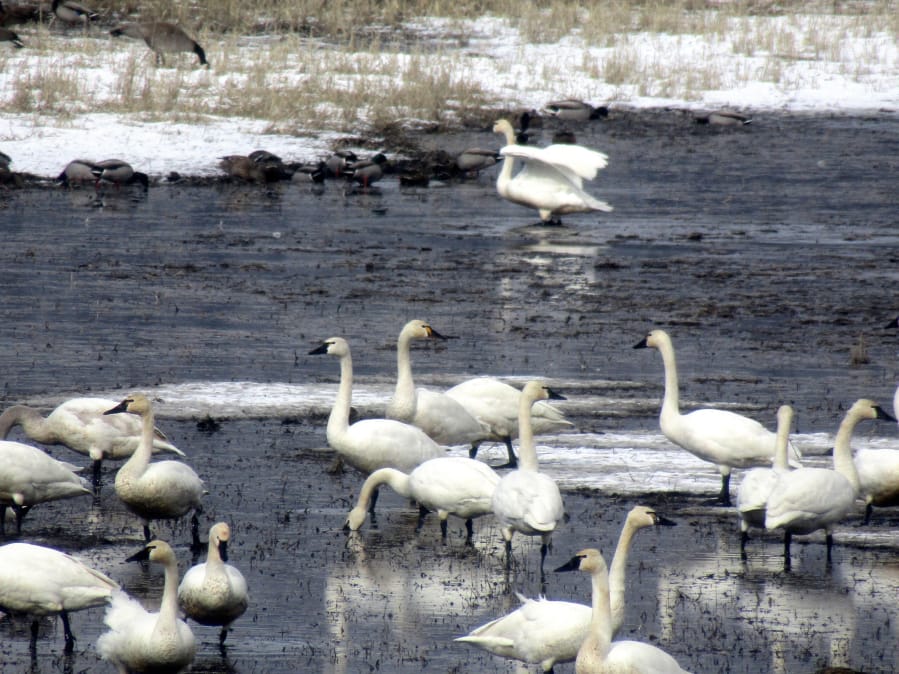EUGENE, Ore. — Bald eagles gather at Upper Klamath Lake in winter to hunt other birds, and so can you.
The Winter Wings Festival in Klamath Falls offers bus tours to see the eagles — and more than 100 other avian species, including ducks, hawks, owls, and finches. The festival is held at the Oregon Institute of Technology, a mile north of downtown Klamath Falls, filling the four-day weekend of Feb. 13-16 with seminars, vendor displays and field trips to see the birds.
The Winter Wings Festival began in 1979 as a conference specifically about bald eagles, inspired by Rachel Carson’s 1960s book “Silent Spring.” That book had documented the decline of eagles and other raptors due to DDT, a pesticide that thinned eggshells.
Here in Klamath Falls, wildlife conservation has often been a flashpoint for controversy. In the 1970s, even saving eagles was suspect. Today, the increasing numbers of bald eagles that congregate here in February and March have become a tourist attraction and a source of local pride.
The first waterfowl preserve in the nation was created at Lower Klamath Lake in 1906 by President Teddy Roosevelt at the urging of William Finley. Finley reported that the nation’s largest flocks of ducks, terns, and egrets congregated each year at these marshy lakes in the high desert as stopovers on their migration routes. He also reported that the flocks were being decimated by “market hunters” who shot tens of thousands to sell the feathers to milliners for women’s fancy hats.
Within 10 years of the preserve’s creation, locals had convinced the Department of Interior to use a loophole in the legislation’s wording to divert the Klamath River away from Lower Klamath Lake, allowing the marshy lake to drain for homesteading farmland. But the lakebed proved to consist of unfarmable peat. By 1920, the former lake had become a weedy desert, with its miles of tule reed swamps dead and the bird flocks gone.
Finley next tried to save the lake next door, Tule Lake, another swampy desert sump full of birds. On opening day of hunting season he reported that a thousand shotguns would open fire on the flocks remaining there — this time for sport rather than feathers. Less than half of Tule Lake was saved for birds. The other half was drained for potato farms, with priority given to World War I veteran homesteaders.
Since then the potato, barley and alfalfa farmers have demanded so much irrigation water that even this wildlife preserve has been threatened, and fish on the Klamath River have been dying for lack of water. But the largest economic driver in the county is no longer agriculture or logging, but rather tourism. People come here to see uncut forests, undrained swamps and birds.
Strangely, the best place to see the birds is now at a private gun club. This hunting area on Upper Klamath Lake is closed to the public, but our bus tour from the Winter Wings Festival was allowed to take a look. We were told that an actual membership in the club costs tens of thousands of dollars and is only available if a previous member dies. We saw hundreds of majestic tundra swans wheeling past jealous bald eagles like sinuous white bombers. The swans are attracted by barley fields that have been left intentionally unharvested by the gun club as bait.
As “color commentator,” I didn’t have to know much about birds. Instead I told stories about Native legends and geology. There’s lots to say on those subjects here.
I also got to know the bus driver. It turns out that the festival is a way for local school bus drivers to earn extra money on the weekend. Instead of ferrying unruly children to suburbs, they drive along farming backroads very slowly, stopping whenever someone shouts, “Somebody’s in that tree at eleven o’clock!” or “Raptor on fencepost!” or “Big nest in cottonwood by the barn!”
At the end of last year’s festival, after a buffet banquet at the Oregon Institute of Technology, the evening keynote talk was given by an Ohio artist who illustrates bird books. She became famous by raising baby birds while documenting their growth day by day in an illustrated notebook.
One of the pleasures of this kind of birding banquet is getting to meet the other people who happen to be at your table. Sitting next to me that evening was the provost of the Oregon Health & Science University in Portland. She told me that she arranged for her medical students to spend a term “abroad” in Klamath County, learning to deal with gunshot wounds, knife lacerations and teen pregnancies.
Most newcomers to Klamath County are California retirees who can’t afford Bend and prefer the leave-me-alone attitude here. But another large share of the newcomers are drawn by the birds and the stark beauty of the high desert. Across the marshy lakes rise the white peaks of Mount McLoughlin and Crater Lake’s rim.
The eagles have made a comeback in the years since the Winter Wings Festival began. And so have the birdwatchers, flocking to Klamath County each February to study and defend the birds.



